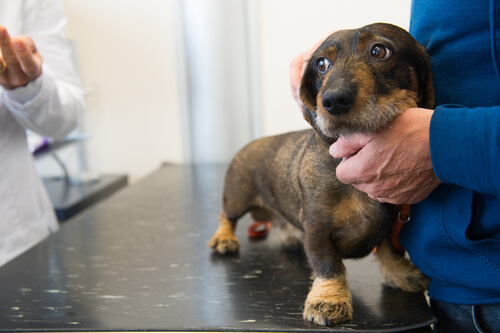What to Do if Your Pet is Poisoned

Although he uses his senses to decide whether or not to eat something, often times a pet is poisoned from substances not considered dangerous. Find out more about how you can save your pet’s life in this article.
How to know if your pet has been poisoned?
Many times the dog or cat plays in the back yard and bites, licks or swallows some a plant. Perhaps, it could be something that puts his life as risk. Therefore, it’s essential for owners to teach our pets not to treat flowers or herbs like toys. If possible, it’s best to start while they’re puppies or kittens.
At the same time, it’s important to be watchful when we take our dog out for a walk. Outside on the street our pet might find some food in bad shape. Or, the food could be poisonous. And, this could cause various reactions.

There are three forms of poisoning for a pet. First: when the substance makes contact with the skin (dermal route). Second: when the pet inhales it (respiratory route). Third: when it ingested something (oral route).
The symptoms of poisoning will obviously depend on the substance and quantity ingested. The most common symptoms are vomiting, diarrhea, excessive salivation and problems breathing, and it even may make the animal feel dejected, with no desire to eat or play.
First, pay attention to the animal’s symptoms. Yet, another way of knowing if your pet is poisoned is knowing the species of plants that are in your garden. Many are dangerous for dogs and cats. A few examples are laurel, croton, ivy, peace lily, fern, gomeroa, blue hyacinth, ficus, mistletoe, lily and holly.
You can also analyze if there’s some change at home. Perhaps, the containers of cleaning supplies or chemical substances are in different locations. Has something spilled? Or is it strewn about the floor? These could be signs that mean that he’s ingested them.
First aid if your pet is poisoned
While the first piece of advice in these cases is to take them to the veterinarian as soon as possible to examine them and determine the cause of the discomfort, we can also practice first aid at home. The techniques or instructions to use depend very much on the type of poisoning, which is why it’s key to know the cause, as it could save the animal’s life.

For example, in the case that the reaction is on the skin from rubbing against a plant, it’s very simple: bathe the dog or cat with tepid water and neutral soap or soap made for pets. If the poisoning is due to inhaling some substance, the best thing to do is to take him somewhere with fresh air, or, if that’s not possible, open the windows of the house.
Finally, if your pet has been poisoned by consuming some dangerous substance, it will need to be expelled through vomiting, which can be induced in several ways. We recommend that before doing so you consult a vet to avoid a reaction that’s even worse.
To make your dog or cat vomit you can give her a spoonful of water mixed with salt, which will need to be given with a syringe down her throat. Do this process only twice and wait for it to take effect.
Alternative methods
Some people also may give their pet a remedy that allows them to clean out the bowels and evacuate the toxic substance through the stool. You can choose between activated charcoal, milk with oil or toast, preferably burned.
Until you get to the vet or hospital, the animal should stay as still as possible. Leave him lying down on his bed or cushion, and put a bowl of cold water beside him in case he wants to drink.
Finally, it’s worth mentioning that prevention is the best way to prevent your pet from being poisoned. We recommend that you keep cleaning products, cosmetics and medications out of his reach; that you watch him vigilantly when he goes out on a walk and that you pay attention to the plants that you have at home.
Source of the first image: Atsushi HASEGAWA
This text is provided for informational purposes only and does not replace consultation with a professional. If in doubt, consult your specialist.